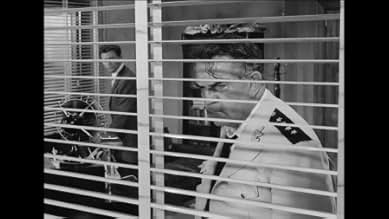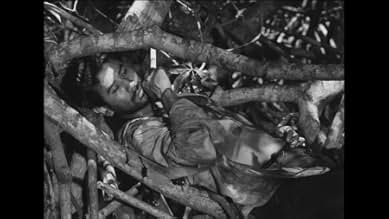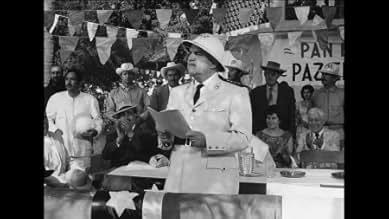La fièvre monte à El Pao
- 1959
- Tous publics
- 1h 37min
NOTE IMDb
6,8/10
1,4 k
MA NOTE
Dans un pays imaginaire d'Amérique latine, l'arrivée d'un nouveau gouverneur qui institue une discipline de fer favorise l'éclosion d'une rébellion qui va faire de nombreuses victimes.Dans un pays imaginaire d'Amérique latine, l'arrivée d'un nouveau gouverneur qui institue une discipline de fer favorise l'éclosion d'une rébellion qui va faire de nombreuses victimes.Dans un pays imaginaire d'Amérique latine, l'arrivée d'un nouveau gouverneur qui institue une discipline de fer favorise l'éclosion d'une rébellion qui va faire de nombreuses victimes.
- Réalisation
- Scénario
- Casting principal
María Félix
- Inés Rojas
- (as Maria Felix)
Miguel Ángel Ferriz
- Le gouverneur Mariano Vargas
- (as M.A. Ferriz)
Raúl Dantés
- Le lieutenant García
- (as Raoul Dantes)
Luis Aceves Castañeda
- López - le secrétaire de Gual
- (non crédité)
Armando Acosta
- Manuel
- (non crédité)
Edmundo Barbero
- Le procureur
- (non crédité)
Augusto Benedico
- Le ministre Sáenz
- (non crédité)
Antonio Bravo
- Le juge
- (non crédité)
José Chávez
- Le chauffeur transportant Inès Rojàs
- (non crédité)
Avis à la une
One of Bunuel's most straightforward films and his most openly political, a drama about an idealist trying to foment rebellion in the fictional town of El Pao. Lacking Bunuel's comic sensibilities or surrealist touch, it's a pretty cut-and-dry affair with few surprises. The social commentary is sharp enough, but the film lacks zing and never seems to get off the ground. The highlight is the sultry performance by Maria Felix as the duplicitous wife of the governor. She gives Bunuel a chance to inject some of his sexual power dynamics and incorporate them into the political sphere. Otherwise, somewhat watchable but unengaging.
For a director like Luis Bunuel,this is a holding pattern movie.Bunuel is neither Costa Gavras nor Alan J Pakula and his political plot falls short of its goal.What's definitely lacking here is madness,the surrealism,almost present at least in one sequence,dear to the great Spanish artist.His art becomes ineffective when it deals with pure drama.The irony seems tamed,subdued.Maria Felix's part is sometimes some kind of Maupassant's "Boule de suif" (a character from the nineteenth century),sometimes some kind of thirties Marlene Dietrich (Sternberg's "dishonored").In a nutshell,originality is not this character's forte.Gerard Philipe (sadly,soon to die from cancer)is miscast and ill-at -ease ,in his part of "intellectual trying to sweeten the dictature".Nevertheless,he ended his career with something more commendable than the disastrous Vadim's "les liaisons dangereuses".
Coming after "Nazarin" "la mort en ce jardin" or "cela s'appelle l'aurore",and preceding such masterworks as "Viridiana" "Belle de Jour" or "Tristana", this fever is not so hot.
Coming after "Nazarin" "la mort en ce jardin" or "cela s'appelle l'aurore",and preceding such masterworks as "Viridiana" "Belle de Jour" or "Tristana", this fever is not so hot.
In the fictitious island of Ojeda, people lives a dictatorship and the island is a penal colony of forced labor with ordinary and political prisoners together. When the Governor Mariano Vargas (Miguel Ángel Ferriz) is murdered by a sniper, his idealistic secretary Ramón Vázquez (Gérard Philipe) is assigned director of security and in charge of the prison. Vázquez is in love with the widow Inés Rojas (Maria Felix) and they have a love affair. But when the new governor Alejandro Gual Miguel (Jean Servais) arrives in the island, he wants Inés to be his lover. Further he forces the killer to sign a false confession telling that Vázquez is the responsible for the attempt against the previous governor and blackmails Inés. But Inés is a female fatale that knows the political games and manipulations.
"La fièvre monte à El Pao" is a political melodrama by Buñuel based on politics instead of his famous surrealism. The theme politics was adopted by Costa-Gravas years later and Glauber Rocha probably wrote his "Terra em Transe" inspired in this movie. Inés Rojas is a femme fatale but the plot is not a film-noir, only the story of an idealistic man that joins politics in a dictatorship and finds how difficult is keep his ideals. My vote is seven.
Title (Brazil): "Os Ambiciosos" ("The Ambitious")
"La fièvre monte à El Pao" is a political melodrama by Buñuel based on politics instead of his famous surrealism. The theme politics was adopted by Costa-Gravas years later and Glauber Rocha probably wrote his "Terra em Transe" inspired in this movie. Inés Rojas is a femme fatale but the plot is not a film-noir, only the story of an idealistic man that joins politics in a dictatorship and finds how difficult is keep his ideals. My vote is seven.
Title (Brazil): "Os Ambiciosos" ("The Ambitious")
for me, its basic virtue is to be the last film of Gerard Philipe. and an experiment , with decent result, of Bunuel trip in politic noir genre. it is far to be a good or a bad movie. because the genre was defined by Costa Gavras , it was very popular in "60 decade and it seems have the status of fragile equilibrium between themes, motifs, explanations, pretexts. the meet between Maria Felix and Jean Servais does the presence of Gerard Philipe almost symbolic. sure, at the second view, his Vazques becomes more realistic but more as the honest young man against a corrupt regime, in clothes of David against Goliath. short, a good film for another side of Bunuel art. for a reasonable portrait of dictatorship. and for few references to Soviet Union. or Franz Kafka.
Known as «Los ambiciosos» in México, the co-producing country where director Luis Buñueñ relocated to, lived and died, as well as in most Latin American territories, this was made in 1959, the year Fidel Castro took power in Cuba, so while anyone can believe the plot and location refers to him and his homeland, they do not. Yes, the island of Ojeda is a Caribbean country ruled by a dictator (Andrés Soler at his meanest - he does receive credit in the Mexican version), but its banana-based economy (no sugar, tobacco or rum, as in Cuba) and the absence of a guerrilla movement, makes it "NowhereLand" with Gérard Philipe (in his last role) as a handsome idealist who falls for the wrong woman (María Félix looking very beautiful). In any case we will never know if Buñuel or in that case novelist Henri Castillou were able to see the future. A good political melodrama.
Le saviez-vous
- AnecdotesIn his memoirs, Buñuel claims to have plagiarized the plot of this film from Puccini's opera "Tosca".
- Crédits fousHalf of the credits are displayed at the beginning of the film: the first seven member of the cast, director, writers, director of photography, composer, conductor, production companies, and executive producer. The closing credits display the other half (after the word "FIN"): Once again the cast list but this time the first eight actors, then the assistant director, script supervisor, unit manager, sound engineer, production manager, followed by the name of the dubbing facilities and laboratories.
- ConnexionsReferenced in Gérard Philipe: un homme pas un ange (2003)
Meilleurs choix
Connectez-vous pour évaluer et suivre la liste de favoris afin de recevoir des recommandations personnalisées
Détails
- Durée1 heure 37 minutes
- Couleur
- Mixage
Contribuer à cette page
Suggérer une modification ou ajouter du contenu manquant

Lacune principale
What is the English language plot outline for La fièvre monte à El Pao (1959)?
Répondre




























